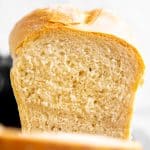Easy Homemade Bread
Learn how to make your own bread - it's so easy, and this recipe turns out perfectly soft and fluffy with a great crust every time.
Servings: 10 slices
Calories: 203kcal
Equipment
- Stand Mixer
- Loaf Pan
Ingredients
- 4 cups all-purpose flour
- 1 tablespoon active dried yeast
- 2 tablespoons butter
- 1 ½ teaspoons salt
- 1 ¼ cups water
Instructions
- Add flour, yeast, butter and salt to the bowl of a stand mixer fitted with the hook attachment.
- Start the mixer on low, then slowly pour the water into the bowl. Knead on medium speed until dough is smooth, about 5-10 minutes.
- Gather dough into a ball, then cover with a clean tea towel and let sit at room temperature until puffy and doubled in size (1-2 hours, depending on room temperature, altitude and humidity).
- Turn dough out on clean, lightly floured countertop. Knead a few times, then shape into a log. Place in a lightly oiled 4x8 inch (OR 5x9 inch - bread will be slightly flatter) loaf pan. Cover with a clean tea towel and let sit at room temperature until puffed up to the top of the pan, about 30-60 minutes.
- To bake, place a small-medium oven-safe dish filled with water in the oven. Heat the oven to 440°F. Slash the bread (kitchen shears work great if you're new to making insicions on bread), then bake around 30 minutes, until bread is golden. Turn bread out of the pan and place on a cooling rack to cool completely.
Video
Notes
Baking tips
Yeast dough tutorial: If you want an in-depth guide with photos on general baking with yeast, I have a comprehensive tutorial here. When to stop kneading: If you're unsure if your dough is done kneading, try the windowpane test: Pull apart a small section of the dough. If you can stretch it paper-thin (almost see through) without it ripping apart, your dough is done kneading! If it rips easily, knead a little longer (photo in tutorial I linked above). Water temperature: There is no need to use warm water here! A lot of people use water that's too hot - this kills the yeast. It's safer to give the dough more time to rest vs accelerating the yeast with warm water. Use less yeast: If you want to use less yeast, you absolutely can. In fact, my husband pretty much always bakes the bread with half (or even a quarter) of the yeast the recipe calls for these days (to save yeast - it's hard to come by right now). It actually gives the bread a nicer flavor, but the dough obviously needs to rest for much longer. But if you have the time and want to use less yeast, it works. Rest time: The time the dough needs to rest and the yeast to grow depends on so many factors, it's hard to put an exact time on it. Altitude makes a big difference (higher altitude = shorter resting time; if you're at high altitude I actually recommend cutting the yeast in half for better flavor). I outline all the possible factors I know in the tutorial I linked above. As a rule of thumb, when your dough is big and puffy and doubled in size - it's ready to be shaped. When the shaped dough reaches the top of your pan - it's ready to bake.Ingredient notes
Flour: You can use half whole wheat, half white instead of all white. Use 1 extra tablespoon butter. Also, add more water as needed (1-4 tablespoons, depending on exact flour used and humidity). Butter: Oil works just as well. We really love this recipe made with olive oil - makes for a more Mediterranean inspired bread. Water: You can also use half milk, half water for a softer bread.Storage
The bread keeps well at room temperature wrapped in a clean tea towel for 1-2 days.Freezer instructions
I recommend freezing the bread sliced, it's easier to defrost. Separate slices with wax paper and place in a freezer bag. Label with the name and use-by date (up to 3 months) and freeze. Defrost single slices on a rack on the counter. Toast before serving for best flavor.Nutrition
Serving: 1slice | Calories: 203kcal | Carbohydrates: 38g | Protein: 5g | Fat: 3g | Saturated Fat: 2g | Cholesterol: 6mg | Sodium: 371mg | Potassium: 57mg | Fiber: 1g | Sugar: 1g | Vitamin A: 70IU | Calcium: 8mg | Iron: 2mg
